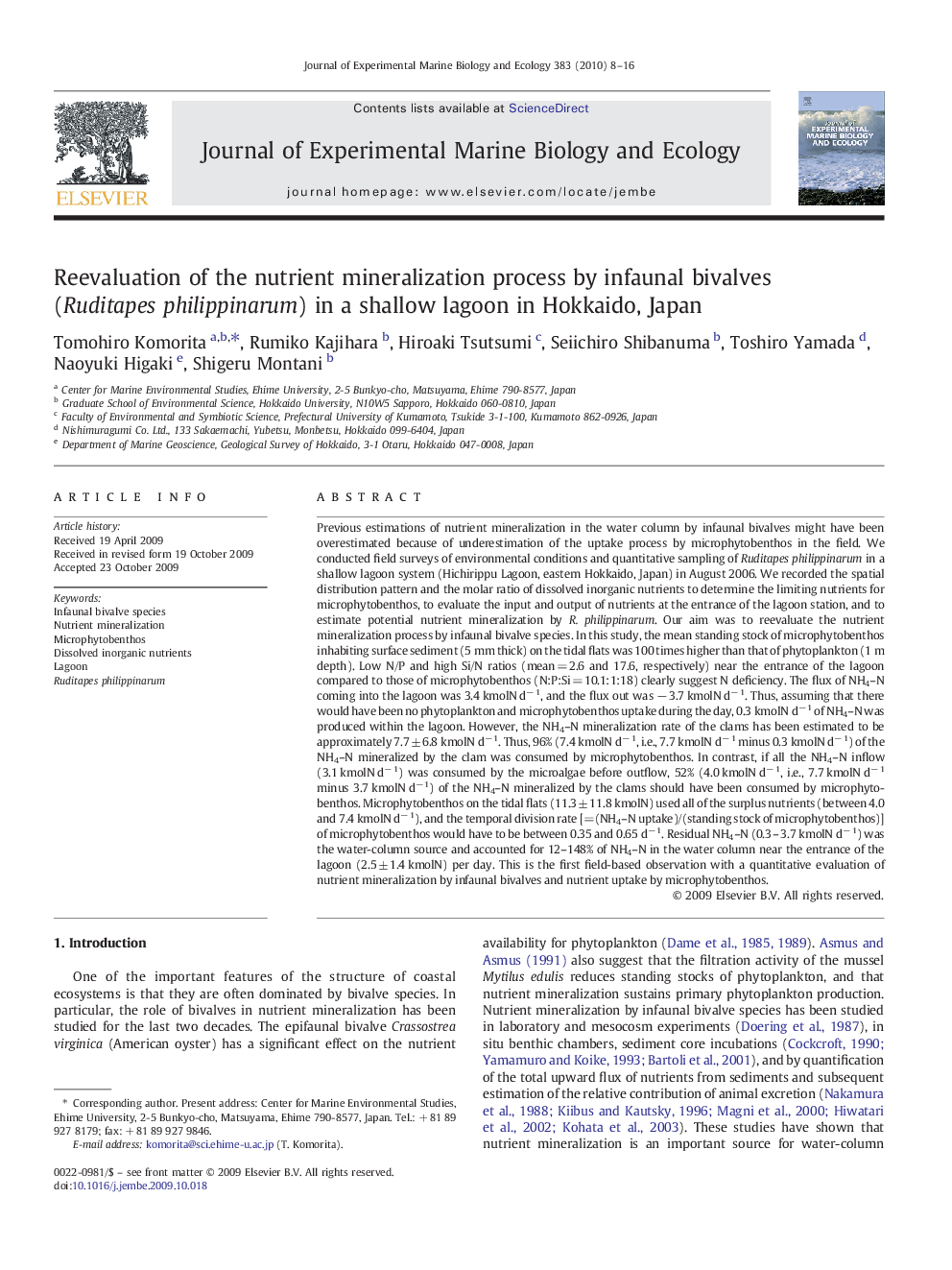| کد مقاله | کد نشریه | سال انتشار | مقاله انگلیسی | نسخه تمام متن |
|---|---|---|---|---|
| 4396813 | 1305844 | 2010 | 9 صفحه PDF | دانلود رایگان |

Previous estimations of nutrient mineralization in the water column by infaunal bivalves might have been overestimated because of underestimation of the uptake process by microphytobenthos in the field. We conducted field surveys of environmental conditions and quantitative sampling of Ruditapes philippinarum in a shallow lagoon system (Hichirippu Lagoon, eastern Hokkaido, Japan) in August 2006. We recorded the spatial distribution pattern and the molar ratio of dissolved inorganic nutrients to determine the limiting nutrients for microphytobenthos, to evaluate the input and output of nutrients at the entrance of the lagoon station, and to estimate potential nutrient mineralization by R. philippinarum. Our aim was to reevaluate the nutrient mineralization process by infaunal bivalve species. In this study, the mean standing stock of microphytobenthos inhabiting surface sediment (5 mm thick) on the tidal flats was 100 times higher than that of phytoplankton (1 m depth). Low N/P and high Si/N ratios (mean = 2.6 and 17.6, respectively) near the entrance of the lagoon compared to those of microphytobenthos (N:P:Si = 10.1:1:18) clearly suggest N deficiency. The flux of NH4–N coming into the lagoon was 3.4 kmolN d− 1, and the flux out was − 3.7 kmolN d− 1. Thus, assuming that there would have been no phytoplankton and microphytobenthos uptake during the day, 0.3 kmolN d− 1 of NH4–N was produced within the lagoon. However, the NH4–N mineralization rate of the clams has been estimated to be approximately 7.7 ± 6.8 kmolN d− 1. Thus, 96% (7.4 kmolN d− 1, i.e., 7.7 kmolN d− 1 minus 0.3 kmolN d− 1) of the NH4–N mineralized by the clam was consumed by microphytobenthos. In contrast, if all the NH4–N inflow (3.1 kmolN d− 1) was consumed by the microalgae before outflow, 52% (4.0 kmolN d− 1, i.e., 7.7 kmolN d− 1 minus 3.7 kmolN d− 1) of the NH4–N mineralized by the clams should have been consumed by microphytobenthos. Microphytobenthos on the tidal flats (11.3 ± 11.8 kmolN) used all of the surplus nutrients (between 4.0 and 7.4 kmolN d− 1), and the temporal division rate [=(NH4–N uptake)/(standing stock of microphytobenthos)] of microphytobenthos would have to be between 0.35 and 0.65 d− 1. Residual NH4–N (0.3 – 3.7 kmolN d− 1) was the water-column source and accounted for 12–148% of NH4–N in the water column near the entrance of the lagoon (2.5 ± 1.4 kmolN) per day. This is the first field-based observation with a quantitative evaluation of nutrient mineralization by infaunal bivalves and nutrient uptake by microphytobenthos.
Journal: Journal of Experimental Marine Biology and Ecology - Volume 383, Issue 1, 31 January 2010, Pages 8–16